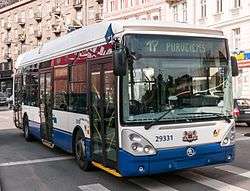Rīgas Satiksme
 | |
| city municipality owned corporation | |
| Industry | Public transportation |
| Founded | 2003 |
| Headquarters | Riga, Latvia |
Area served | Riga |
| Parent | N/A |
| Website | www.rigassatiksme.lv |
Rīgas Satiksme (English: Riga Transport) is a limited liability company of Riga municipality which operates public transport and vehicle hire in the Latvian capital Riga and its surrounding areas. The organisation's principal activities involve the operation of the city's 476 buses, 354 trolleybuses and 267 trams.[1] It is also responsible for the operation of the city's car parks. It currently employs nearly 5000 staff members.[1]
History
Rīgas Satiksme was founded on February 20, 2003[1] as an umbrella organisation for the respective operators of trams, buses and trolleybuses in the city of Riga. Two years later, the separate operators of the different modes of public transport were merged and re-branded as Rīgas Satiksme, making it the largest provider of public transport in Riga.
Buses
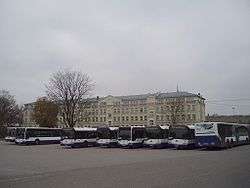
In 2005 Rīgas Satiksme was responsible for the operation of some 460 buses on a total of 57 routes [2] across the city and its suburbs, as well as 15 regional routes connecting Riga with its surrounding towns.[2]
Livery
All buses are painted blue and white except Ikarus E91's which are yellow.
Trolleybuses
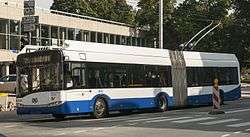
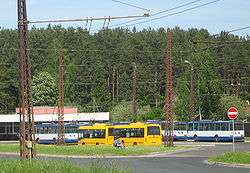
The first trolleybuses in Riga entered service in 1947, using a portion of the budget initially set aside for the new tramway, with the intention of moving slightly slower trams away from the city centre to allow for faster trolleybuses. The service was operated initially by Soviet-built units, although these were later replaced by Škoda vehicles brought in from Czechoslovakia. Conductors remained on trolleybuses for 5 years after they disappeared from the buses, with electronic ticket machines replacing them in 1975. Conductors were re-introduced on the trolleybus network in 1997. From 2007 new electric ticket machines were installed and conductors disappeared. In 2009 electronic ticket machines were replaced with e-tickets (E-talons).[3]
Rīgas Satiksme is responsible for the operation of 19 trolleybus routes throughout the city.[2]
Trolleybus routes
| Number | Start point | End point |
|---|---|---|
| 1 | Pētersalas Street | Valmieras Street |
| 3 | Riga Central Market | Sarkandaugava |
| 5 | Daugavas Stadium | Riga Clinical Hospital |
| 9 | Iļģuciems | Riga Central Station |
| 11 | Ieriķu Street | Riga Central Station |
| 12 | Šmerlis | Āgenskalna priedes |
| 13 | Ieriķu Street | Riga Central Market |
| 14 | Mežciems | Esplanāde |
| 15 | Ķengarags | Latvian University |
| 16 | Šmerlis | Pļavnieki |
| 17 | Purvciems | Riga Central Station |
| 18 | Mežciems | Riga Central Station |
| 19 | Pētersalas Street | Ziepniekkalns |
| 20 | Latvian Television | Latvian University |
| 22 | Katlakalna Street | E. Birznieka Upīša Street |
| 23 | Purvciems | Riga Central Station |
| 24 | Pētersalas Street | A/S "Dzintars" |
| 25 | Iļģuciems | Brīvības Street |
| 27 | Ziepniekkalns | Riga Central Station |
Livery
Trolleybuses are painted in the same blue and white colours as buses, although some carry advertising. Older trolleybuses still hold the old TTP two tone blue and white.
Trams
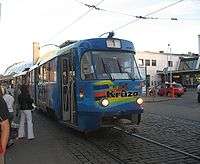
Trams have been in operation in Riga longer than any other mode of public transport, with the first horse-drawn trams entering service in 1882. In 1900 it was agreed that a number of electric tram lines would be built in the city, with the first electric trams starting operation in 1901.[4] Tram construction continued until the outbreak of World War I. Operation of the tramways remained largely unchanged until 1918 and the emergence for the first time of Latvia as an independent nation, when a Belgian company took over. This period of private ownership was deemed a failure, and the city authorities regained control of the tram network in 1931. World War II devastated Riga's public transport system, and it was gradually re-built to its current level.[4]
In 2002, Rīgas Vagonbūves Rūpnīca signed an agreement with the Mayor of Riga which would see the company replace the trams in Riga once their period of operation ended in 2010. The new trams would have offered enhanced comfort and safety, as well as would be far quieter than the city's current fleet of elderly ČKD Tatra units.
According to RVR they would have featured bright and spacious interiors and would have been 20-30% more power efficient than their predecessors. The new units were expected to be produced at a rate of 15-20 per year and would have resulted in a gradual phasing out of the Tatra tramcars.[5] Instead, 20 Škoda 15 T trams were built for Riga and entered service in spring 2010.
Tram lines
| Number | Start point | End point |
|---|---|---|
| 1 | Jugla | Imanta |
| 2 | Tapešu Street | Riga Central Market |
| 3 | Shopping Center "Dole" | Jugla |
| 4 | Imanta | Riga Central Market |
| 5 | Iļģuciems | Mīlgrāvis |
| 6 | Jugla | Ausekļa Street |
| 7 | Shopping Center "Dole" | Ausekļa Street |
| 9 | Shopping Center "Dole" | A/S "Aldaris" |
| 10 | Bišumuiža | Riga Central Market |
| 11 | Mežaparks | Ausekļa Street |
Fares
A flat fare (applies from 1 February 2015) of 1.15 EUR per single journey ( 2.00 EUR, if bought from the driver) applies on all Rīgas Satiksme bus, tram and trolleybus services within the city boundaries. Fares on the regional bus routes vary depending on the journey destination.
The method of fare collection on public transport in Riga was by conductor since 1996,[6] and indeed this practice was widespread on buses operated by Rīgas Satiksme even after conductors were phased out in trams and trolleybuses.
See also
- Pasažieru Vilciens (Commuter rail & national passenger rail)
- Riga International Coach Terminal
References
- 1 2 3 "About us". Rīgas Satiksme. Retrieved 2011-11-30.
- 1 2 3 "Traffic schedules". Rīgas Satiksme. Retrieved 2007-06-12.
- ↑ "History of trolleybuses in Riga". Rīgas Satiksme. Retrieved 2007-06-16.
- 1 2 "1901. : History : About us : Rīgas Satiksme". Rīgas Satiksme. Retrieved 2013-07-13.
- ↑ "trams". RVR. Retrieved 2007-07-12.
- ↑ "Conductors". Rīgas Satiksme. Retrieved 2007-06-14.
